ShodhKosh: Journal of Visual and Performing ArtsISSN (Online): 2582-7472
|
|
A REVIEW ON HAND BLOCK PRINTING IN INDIA
1 Assistant
Professor, Department of Home Science, Women’s Christian College, Chennai,
India
|
|
ABSTRACT |
||
|
India is well known for its art and culture which makes the country unique. There are several forms of art which have been nurtured and groomed under skilled guidance and has been inherited through generations of family traditions. Hand Block Printing is one such an art, which can be used to make every design and every piece of fabric exclusive from the other. Hence block printing is considered to be the most interesting method of designing textiles. Printing is the process of applying colour to fabric or yarn in a definite and repeated pattern. Every design created using hand block printing is very exclusive and different from each other. However, this cannot be achieved by automated printing machines where several meters of fabric can be printed with the same design and colour in a short time. India’s
block-printed fabric holds a place of pride in the world market. India is one
of the major producers and exporters of block printed fabrics. It is amazing
that each region of the country has developed variations in this traditional
craft, to name a few, Dabu print of Rajasthan which
uses the mud printing technique, Ajrakh print of
Gujarat known for geometric motifs and Kalamkari of Andra Pradesh. The
various styles of block printing are symbolic of the country’s rich heritage
and culture. This article explains the process of block printing and the
various styles of block printing methods practiced in India. |
|||
|
Received 18 September 2023 Accepted 15 February 2024 Published 09 March 2024 Corresponding Author Preetha R,
preetha@wcc.edu.in
DOI 10.29121/shodhkosh.v5.i1.2024.689 Funding: This research
received no specific grant from any funding agency in the public, commercial,
or not-for-profit sectors. Copyright: © 2024 The
Author(s). This work is licensed under a Creative Commons
Attribution 4.0 International License. With the
license CC-BY, authors retain the copyright, allowing anyone to download,
reuse, re-print, modify, distribute, and/or copy their contribution. The work
must be properly attributed to its author.
|
|||
|
Keywords: Hand Block Printing, Natural Dyes, Steps in Block
Printing, Dabu Print, Ajrakh |
|||
1. INTRODUCTION
Textiles
is one of the most successful exports of India and as its oldest craft Hand
block printing has sustained and is thriving even in this digital age Edwards (2016).The word ‘printing’ originates from Latin,
which means ‘pressing’, this implies to the pressure applied to transfer the
design during the printing process Kiron (2012). Printing is an important step in
the textile manufacturing process. It is generally done on the fabric but
sometimes it is done on the finished garment. The process of applying colour to
a selected area which produces a design is Printing Hossain et al. (2015). This process involves the
production of images or designs of various intricacies with a range of colours.
This localised application of colour to produce the desired pattern should be
carried out carefully. The time taken to complete this process depends upon the
complexity of the design and the number of colours used in the design Wardman (2018).
In
printing, the thickened pigment colorant is applied with the help of a tool -
printing machine. The thickening agents present in the pigment prevent the
colour from spreading by capillary action on the fabric. Wooden blocks,
stencils, rollers, or silk screens are the tools which are used to do printing
on the fabric. These are used to confine the flow of the colouring paste while
printing the designs on the fabric Choudhury (2023). Of all the printing process done
on textiles, block printing is the oldest and generally considered to be the
most artistic of all. Block printing was practiced in India since 3,000 BC.
Scraps of block printed cloths were found in the ruins from Mohenjo Daro, an
ancient city of Indus Valley civilization Mandal & Jaiswal (2019).
Hand
block print is a labour-intense and painstaking process that has survived since
ancient times because of the exquisite handmade products. The early blocks were
made out of terracotta or clay, others were made out
of carved wood Choudhury (2023) Block printing is still practiced
today as a handcraft by the cottage or small-scale industry. Blocks cane either
carved out of wood or made with metal pieces which are shaped and attached
securely to the wooden base. Each block can print only one colour, so if a
design with several colours is desired a block must be made for each colour. In
preparing a wooden block, the design area remains raised while background is
carved away. The fabrics discovered earlier by the archaeologists have been
printed with small blocks no larger than 1-2 inches in diameter. By the 15th
century the blocks have grown to 12-18 inches diameter and 2.5-3.5 inches
thick. Recently blocks are also made using foam for home crafts.
Figure 1

|
Figure 1 Different Types of Blocks Source Author |
Block
printing is a centuries old art form and the essence of India which has made
India stand out in the world. Every design created using hand block printing is
very exclusive and different from other printing methods. However, this
printing technique cannot be duplicated by automated machinery where several
metres of fabric are printed in few seconds with the same design and colour.
The factory-printed (using machine) fabric are low-priced and have good
colourfastness compared to fabrics that are hand block printed. Still, hand
block printed fabrics manifests human labour and emotional response of the
artisans which can never be seen on machine-made fabric. In India hand block
printing is a skill that has been passed over many generations and provides a
sustainable income to artisans Rahman (2022).
Every
generation has contributed towards the enhancement and artistic beauty of this
art. Block printing represents cultural and social trends Qutub et al. (2022). This art is an indigenous art
because of its rich and traditional roots and the efforts taken by the
artisans. Hand block printing was traditionally done using Natural Dyes which
makes it very unique and has to be preserved. Recently
hand block printed fabric is found its use in the metropolitan cities and block
printed garments are being exported to several countries worldwide Rahman (2022).
In India
block printed fabric have been integrated into dress code and plays a key role
serving the domestic and ritual functions of the subcontinent Edwards (2016). Traditional hand block printing in
India as usually done on sarees, suits, kurtis, bedspreads,
upholstery and household articles to name a few Anjum & Kunwar (2020). Consumers are moving towards more
artistic and unique choices which will also positively influence the textile
printing market. As the demand for block printed textiles is expected to
increase globally, the growth and market for the same is believed to increase
in the coming future. Mandal & Jaiswal (2019).
2. The block printing process
Earlier the
entire block printing process was done with naturally occurring materials. The
fabric to be scoured was soaked for 24 hours in cow dung/ sheep dung mixed
water. This was done to remove the natural and added impurities from the
fabric. The fabric was then rinsed in water and dried in sunlight on bamboo
lines or spread on the ground. This made the fabric more permeable for the
printing process.
The vessels used
in the process such as copper vessels and earthen pots also had a major role in
the colour development Chouhan & Patil (2019).
In certain block printing techniques, the fabric was
Mordanted (A mordent helps to fix the colour on the fabric hence the fabric
will have good colourfastness to light and washing). The scoured fabric was
treated with harda or myrobalan (15 to 20 %
myrobalan). The mordanted fabric turns yellow after it is dried. Alum- phitkari was also used as a mordant it has minerals to fix
the colours Hada (2015).
The ancient
records show that natural dyes were largely used to colour textiles Singh (2022). Natural dyes were preferred for
their gentle shades. Printing on cotton fabric with myrobalan fruit,
pomegranate rind and catechu gave unique shades Rana et al. (2022).
1) Red is produced by combining alizarin
with alum, the colour may range from pink to dark red. Manjistha (Rubia
cordifolia) www.fibre2fashion.com. (n.d.) and Powdered Tamarind seeds with
alum also produced red Sampath (2023).
2) Indigo Blue can be extracted from the
leaves of indigo bush which is found all over India.
3) Black is obtained by using rusted
iron, nails and old jaggery the paste is prepared which is then kept in earthen
pots kept under shade for 15 to 25 days depending on the weather.
4) Green obtained when alum mordanted
fabric is dyed with pomegranate rind and heena.
5) Yellow obtained from flowers like kesula to get various shades when mixture with alum as
mordent Hada (2015) Lal Chandan (Adenanthera
pavonina) bark www.fibre2fashion.com. (n.d.) .
6) Mustard colour: Pomegranate skins
were used to produce mustard colour Chouhan & Patil (2019).
7) Brown: Catechu and Heena produced
light to dark brown shades based on the mordants used Vankar (2022).
3. Motifs used in
block printing
The Indian block
printing has a diverse regional style. Each region and community in India has its unique motifs. Each motif with its cultural
significance contributes to the enduring beauty of this traditional craft.
The common motifs seen in Indian block printing are
· Floral Pattern are the most popular motif in Indian
block printing. Images of flowers like roses, lotus and jasmine are common. The
design ranges from simple petals to realistic floral images. These patterns are
also combined with leaves, vines etc.
· Paisley Motifs the teardrop-shaped motif, known as
“mango” or “ambi,” is a popular pattern of Indian
block printing characterized by curved lines and intricate designs. This is a
very distinct motif of Inia and may have originated from Persia.
· Geometric Patterns are obtained from repeating the
geometric shapes like squares, triangles, circles, and hexagons placed in a
symmetric manner. These patterns have similarities reflecting the
influence of Islamic art.
· Animals and birds motifs hold a significant place in
the Indian culture. Elephants, camels, parrots, peacocks, and sparrows are some
of the common motifs used. They are portrayed either individually or depicted
as part of larger narrative scenes.
· Figurative design represents human figures engaged in
various activities exhibiting traditional scenes, cultural practices, and
religious stories. These figures have intricate detailing on costumes and jewellery.
· Borders have geometric patterns, floral designs, or
abstract pattern which add beauty to the product Hill’s (2023).
The motifs on the
printed cloth served as social designators. The printed fabric based on the
colour, motif and pattern were used to differentiate religion, gender,
ethnicity, socio-economic status, occupation, and marital status of the people Balotra Printing. (n.d.).
4. Steps involved in Block
printing
1)
Preparation of the block
Hand-carved wooden blocks were the basis of the block
printing process. The process of carving the block is a tedious process which
requires an extraordinary skill. This
skill has been passed over generations. There are two types of blocks used to
create the desired design namely Rekh- the block used
to create an outline pattern and Gadh- the block used to create a filling
pattern. Carving the block for creating the outline is a challenging process in
block printing. As the skeleton for the design, it is the more expensive as the
block is prepared by the most skilful artisan. Blocks have a wooden handle and two or three cylindrical holes are drilled into
the block which allows the free air passage and the release of excess printing
paste. The newly carved blocks are soaked in oil for 10-15 days which soften
the grains Marigold (2020).
The
blocks are normally made using sheesham wood. The
first step is to draw the design or the motif on a paper. Once the design is
approved, the carver prepares the block by coating the surface of the wood with
a white paste to make the surface of the wood uniform and smooth for carving.
The carver then carves the wooden block so that the design alone remains
raised. This is done by hand using a
very small chisel. This process requires skill, experience, and patience hence
it is a labour-intensive process.
Figure 2

|
Figure 2 Steps in the Preparation of
Block Source Krishnamurthi Hand Blocks,
Chennai |
The
completed blocks are checked for accuracy after which it is soaked in oil to
cure the wood, which prevents cracks. A block can print only a single colour
hence different blocks are carved based on the number of colours to be used and
each block is designed in a manner to fit exactly into the other. Hence extra
time and attention are needed to align blocks correctly.
Figure 3

|
Figure 3 Blocks Based on the
Patterns they Produce on the Fabric Source Author |
Metallic block: The metallic blocks
are prepared from metal sheets, using manual hand beaten process. The metal is
made into wafer thin thickness and are pliable. The thin sheets are cut into
narrow strips which are even in length. The patterns required on the block is
first drawn on the wooden block and the thin metal strips are pressed onto the
pattern and gently hammered in place. The designs using the metal are done by
hand, it is done from the centre to the outside. After the design is placed in
position, the block is checked to ensure that the strips are of uniform height
from the wooden base. The brass (metallic) blocks are used for fine designs and
for high clarity in print. These blocks are more expensive as it is more time
consuming to make and it is long lasting Ganguly & Amrita (2013a).
2)
Preparation of the fabric
The
fabric to be printed should be bleached and scoured (washed) so that it does
not have any impurities. The pigment will be uniformly absorbed by the fabric
only if it is starch and impurity free.
3)
Preparation of the Printing pad
The
colouring material- printing paste is poured over a layer of sponge or felt
material kept in a tub so that there is an even spread of the pigment paste and
when the block is placed on the sponge the dye paste is evenly taken up by the
block.
4)
Preparation of the Printing table
Block
printing process requires a solid table made of either wood, stone, iron, or
concrete. The table has to be padded hence it is
covered with a back-grey plain cotton cloth which is usually stretched over the
table to help in the proper spread of colour by blocks and absorb any extra
pigment. The length of the table depends on the length, quantity, and nature of
the material to be printed.
5)
Block printing process
The
fabric is pinned on the printing table neatly without any crease. The wooden
block is pressed on the sponge (which is loaded with pigment paste) and then it
is placed on the fabric and pressed or beaten with a mallet to get the
impression of the pattern. The printing is done carefully if a continuous
pattern is desired then the process is repeated to form a proper repeat.
Individual designs or prints-buttas are done on the
body of the fabric after planning the pattern on the fabric. If different
colours are required for printing the outline is done first followed by the
filling of the pattern inside using other blocks with different colours. The
process has to be done carefully to produce a neat
design. The border design is printed first followed by the printing inside the
border of the fabric Singh (2021).
Figure 4

|
Figure 4 Block Printing Process Source Author |
6)
Curing the block printed fabric
After
printing, the cloth is sun dried as a fixing process and then subjected to
steaming to ensure that the colour has fixed well in the fabric. Finally, the
block printed fabric is washed, rinsed, and ironed.
5. Hand block printing in India
India is
famous for hand block printing and the important centres for block printing are
Madhya Pradesh, Rajasthan, Uttar Pradesh, Gujarat, Andra Pradesh, and West
Bengal.
1)
Madhya Pradesh
Bagh is a
tribal town in Madhya Pradesh, the name originated from baghs
or tigers that lived in that region. This region has the Baghini
River which has high copper content accounting for the beautiful colours
developed on the fabrics. Also, the flowing water contributes to dyeing Chouhan (2019). The Bagh printers use Natural
dyes, typically bright shades of red, indigo, and black. Bagh block prints
produce a characteristic three-dimensional effect which is not possible to be
replicated by the machine printing process or screen printing. The blocks used
in making bagh prints are made of intricate and
stylized motifs, a traditional art which has evolved over hundreds of years Ganguly & Amrita (2013b) In Indore, this traditional art of Hand Block
printing is still kept alive by the fifth generation of block printers
who have their origins from 'Nagore', a village in Rajasthan.
Figure 5

|
Figure 5 Bagh Print Sari Source theindianethnicco.com |
Nandana
is a wax resist printing and dyeing process which has 18 steps. This printing
is done on thick and heavy-duty cotton fabric.
The motifs used in this printing are few and are used in backdrop of
deep, dark, and rich colours which suit the rough use by the hard-working Bhil
and Bhilal community people who were engaged in
farming (“Nandana Hand Block Printed Textiles,” 2024). The motifs used were
Mirch (chilli), Amba (mango) and Jalam buta (creeper
web).
Figure 6
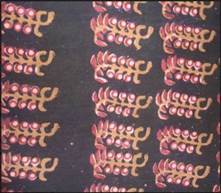
|
Figure 6 Nandana
Block Print Source “Nandana Hand Block Printed Textiles,” 2024 |
2)
Rajasthan
This
region is famous for eye-catching, colourful dressing. These are obtained from
the unique dyeing and printing techniques using vegetable colours, which is
done mostly on cotton fabric. This oldest technique of dyeing and printing are
conserved in the state. Royals in Rajasthan patronize this art of printing. The
block print patterns consist of gods, goddesses, birds, human figures, and
animals. Jaipur, Pali, Bagru, Barmer and Sanganer are
the main centers in Rajasthan which are well known
for this form of Hand Block Printing. Barmer is famous for motifs of red with
black-blue outlines, surrounded by flower-laden trees and is well known for
turbans, sarees, and traditionally worn lungis. The
villages of Jahota in Jaipur is
famous for the Jahota hand block printing Ganguly & Amrita (2013b).
Figure 7
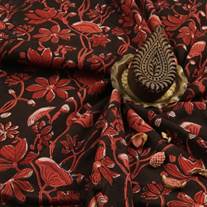
|
Figure 7 Black Botanical Floral Jahota Hand Block Printed Cotton Fabric Source theindianethnicco.com |
“DABU”
print is one of the oldest, most famous and favoured folk form resist printing
of Rajasthan. This art is originally an Indian printing technique which was
developed centuries before the mughals invaded India.
‘Dabu or Daboo’ is a traditional mud resist
block printing done on natural fabric with dark earthy tones with fabulous
designs and traditional patterns. It is done with carved wooden
or metal blocks the stamp is done using Mud resist print techniques Kaur (2012).
Figure 8

|
Figure 8 White Bud Dabu Printed Fabric Source theindianethnicco.com |
Sanganer
and Bagru villages near Jaipur have two prominent
settlements of Hand block printers. Though the printing methods followed in
these two regions are similar, each village has its own mark on the fabric. The
availability of water in these villages plays a major role in the manufacture
of the block printed fabric. Each area has a significant design and colour
printed fabric. In Sanganer village, water is available in abundance hence
washing and printing are easily done. But the Bagru
village has scarcity of water and the reddish tinge the water leaves is a characteristic shade on the fabric (The Craft of Hand
Block Printing).
Figure 9
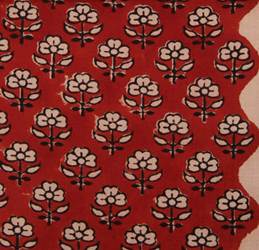
|
Figure 9 Bagru Print Source theindianethnicco.com |
The main
difference between Sanganeri and Bagru
styles of block printing, is the colour of background on which they are
printed. The background colour for Bagru prints is
black and red while the Sanganeri print is known for
delicate lines of bright colours printed against white background. Sanganeri print has prevailed since 12th century
and it flourished under the patronage Maharaja Sawai Jai Singh, who invited
people from Gujarat and Andhra for creating new designs Baral (n.d.).
Figure 10
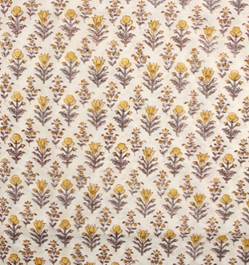
|
Figure 10 Sanganeri Print Source theindianethnicco.com |
The Balotra printing is named after the city Balotra, Barmer district of Rajasthan. This block printing technique belongs to the Chhipa community. The printed fabrics are
characterized by vertical floral patterns and geometric butis in tones of earthy red, yellow, or cream, on a
background that is dyed in indigo or dark green. These butis
are generally large and are often printed without the black rekh, producing bold and simple designs
without the shades of colour. A unique feature of Balotra
printing, is printing is done on both sides of the cloth.
Figure 11
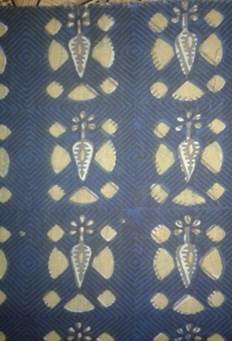
|
Figure 11 Balotra Print Source EcoFab:
Balotra Handblock
Printing: Rajasthan’s Bounty ecofabstories.blogspot.com |
The fabric, is washed to remove the impurities and to make the fibres soft. Saaj, a process in which the fabric is subjected to a mixture of castor oil, camel or goat dung, and soda ash. The fabric is then soaked in a paste of harda, while wet which gives the fabric a yellow shade and allows it to develop into deep black. When the fabric is dry, the designs are transferred to the fabric using the wooden blocks. The first step in this process is direct printing — in which the dye is applied to the block and dabbed onto the fabric and then the second step is using dabu (or dye-resist) printing Balotra Printing. (n.d.).
3)
Gujarat
Sodagiri
(trader) prints is a hand printing technique practiced by Paithapur
families in Gujarat. This is a mud resist – printing method which is used to
print textiles and intricate blocks are prepared. In Kutch the famous patterns
dancing girls, birds and animals are done using black and red colours. In
Ahmedabad and Baroda large mango motifs against the background of red or blue
are done on the saris Ganguly & Amrita (2013b).
Figure 12
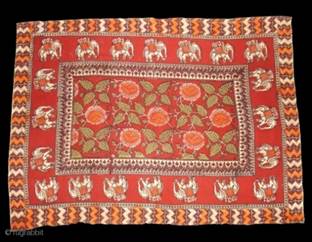
|
Figure 12 Sodagiri Block Print Source rugrabbit.com |
Another
famous printing technique of Gujarat is the Ajrakh, a
double sided printed textile which is considered to be
the oldest living textiles in the world. This art is considered to be
indigenous and symbolise the land, through which the river Indus flows Karolia & Buch (2008).The name Ajrakh
is derived from the Arabic word- Blue, as indigo is one of the predominant colour in this printing.
Figure 13
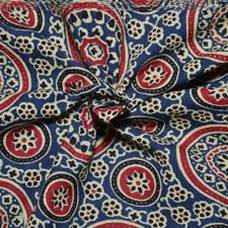
|
Figure 13 Cotton Fabric with Ajarkh Print Source yehaindia.com |
Figure 14
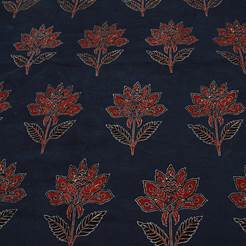
|
Figure 14 Indigo Madder Floral Ajrakh Hand Block Printed Cotton Fabric Source theindianethnicco.com |
The Ajrakh painted cloth has colours like blue, black, red, and
white in several patterns. The Ajarkh printing
comprises of the resist and mordant printing process which consists of nearly
14 to 16 stages. It produces several borders of patterns with centre filed Williamson (2016).
Mata ni Pachedi is also called the
Kalamkari of Gujarat which follows similar techniques of Kalamkari. It is a
craft of religious significance of the Vagri
community Kulkarani (2021)
The two
techniques followed to create the Mata ni Pachedi are wooden block-printing and painting. Block
printing is done for borders and certain figures and painting using brush for
freestyle drawing, embellishments are incorporated by the artist. The patterns include the sun and the moon, which are
generally on the two top corners; it also includes singers, musicians, sages, animals,
and birds which seem to dance and fly in celebration of the goddess. The
fineness of these patterns depend on the carving skills
of the block maker and the artistic skills of the painter How Mata ni
Pachedi is Created. (n.d.).
Figure 15
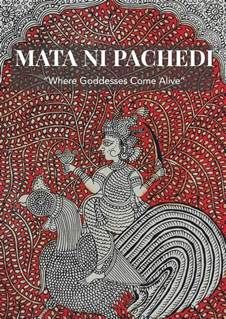
|
Figure 15 Mata Ni Pachedi Source Kulkarani,
2021 |
Gamati print originated from
Gujarat and Rajasthan. It uses lively and bold colours. The intricate designs
used in Gamati print are mainly inspiration from nature. Earlier only natural
dyes were used in this type of printing, but at present it has been replaced by
chemical dyes. The natural colours used were, henna (green), turmeric (yellow),
indigo (blue), and rusted iron (black), about 27 colours were obtained from
different parts of the plant and metals. The blocks were made from seasoned
teak wood. The designs are etched, two to three cylindrical holes are drilled
vertically and horizontally across the body of the block, which ensured free
passage of air and release of excess printing paste, which make the blocks
unique 9 types of block printing
techniques across India. (n.d.).
Figure 16
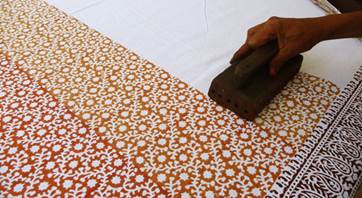
|
Figure 16 Gamati Print Source Edwards,
2016 |
Varak
Gold And Silver Leaf Printing: In this printing gold or silver was flattened to
a fine paper like thickness which was hand printed as a prestige of the
possessor onto the flags, coats of arm, royal tents, and other emblems of
power. The traditional Varak leaf printing is employed to decorate textiles
used in temples till today. The glittering
Varak leaf prints, had a niche use because of the cost, as
these textiles do not lend itself to the rigorous washing to its fading
away over time.
Figure 17
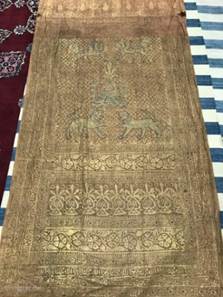
|
Figure 17 Varak Gold and Silver Leaf Printing Source 19th Century India Gold Block Print
Textile. Gold leaf block print using the Varak technique of transferring gold
leaf from paper to block print. Made in Gujarat with symbols of the Nawab
Sahib ... | rugrabbit.com. (n.d.) |
The Varak
printed textiles can be seen in large temple towns and several past royal
cities in India Past-Continuous: Block Printing
on Textiles in India. (n.d.). The varak
block printing technique is extremely rare today and there are only two
printers who practice this printing in Jaipur Indian prints that are the face
of India’s heritage—Textile Magazine, Textile News, Apparel News, Fashion News.
(n.d.).
4)
Uttar Pradesh
Uttar
Pradesh is a center of block printing for temple
dresses or Nawabi royal attire. This state has a great influence of
Indo-Persian culture which is reflected in its art and textile industry. Uttar
Pradesh is famous for its tree like motives which is printed on either plain or
dyed cloth. The most famous motif of Farrukhabad is the “Tree of life” motif.
This motif stamped on silk fabric earns high foreign exchange. Beautiful
paisley motifs are seen in the hand block printed fabrics. Jehangirabad,
is another block printing centre, is famous for its low toned colours and bold
lines. Tanda in Uttar Pradesh is well known for its detail printing. Red and
dark blue, blend with red against an indigo background, are the main colours
used for block printing here Singh (2022).
Figure 18
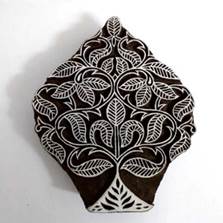
|
Figure 18 Tree of Life Block Source desicraftshop.com |
5)
Andhra Pradesh
One of
the earliest but a complex technique of block printing developed in
Machilipatnam in Andhra Pradesh is Kalamkari. This craft evolved with the
patronage of the Golconda sultanate at Pedana near
Machilipatnam and the Mughals.
‘Kalam’
is only tool used in making these painted cloths. It is a brush made using
bamboo stick pointed at one end while the other end is thick. In the middle of
the stick wool or jute yarns are tied around to form of a ball and is held by
twine which is wrapped around in a crisscross manner. This craft uses only
natural dyes Divakala & Vasantha (n.d.).
Figure 19
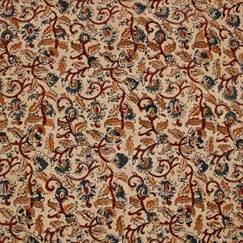
|
Figure 19 Kalamkari Hand Printed Cotton Fabric Source theindianethnicco.com |
|
6)
West Bengal
Santiniketan is renowned for its distinct
style of block printing. This artistic tradition has deep roots in the cultural
and educational ethos. It was established by the Nobel laureate Rabindranath
Tagore which connects students with nature and traditional Indian arts. The
prints often reflect the ethos of Santiniketan, featuring nature-inspired
motifs, rural life, and themes from Tagore's literary and poetic works. The
blocks feature detailed patterns, often inspired by elements of nature,
folklore, and traditional Bengali art. Using natural dyes derived from plants
and minerals this printing produces earthy tones and vibrant hues, contributing
to the eco-friendly and sustainable nature of the craft Raman (1997).
6. Conclusion
India is well known for its hand block printing. This craft has played an important role in establishing the reputation of India for a very long time and has its market within and outside the country. Block printing is an art and a way to decorate the surface of the fabric for enhancing the appearance of the same. This traditional craft has been very much appreciated around the world because of the wonderful patterns created by hand. Each state in India has its unique style of block printing ranging from delicate patterns and lines to elaborate designs with vibrant colours, use of natural dyes. Another fascinating fact is the water in some regions producing unique colours. In spite of challenges from other modern printing techniques in the fashion industry this traditional art is still skilfully used for designing apparels and household articles, by varying combinations of motifs and colour, giving us a wide range of choices with a sense of uniqueness.
CONFLICT OF INTERESTS
None.
ACKNOWLEDGMENTS
None.
REFERENCES
9 types of block printing techniques across India. (n.d.). Retrieved from 2024, January 11.
19th Century India Gold Block Print Textile. Gold leaf block print using the Varak technique of transferring gold leaf from paper to block print. Made in Gujarat with symbols of the Nawab Sahib ... | rugrabbit.com. (n.d.). Retrieved from 2024, January 14.
Anjum, S., & Kunwar, N. (2020). Designs of Block Printing and Use of Techniques.
Balotra Printing. (n.d.). MAP Academy. Retrieved from 2024, January 12.
Baral, B. (n.d.). Sanganer Block Printing. D’Source Digital Learning Environment for Design.
Choudhury, A. K. R. (2023). Principles of Textile Printing—1st Edition -.
Chouhan, K. (2019). Historical View on Block Printing Technique and its Used in Bagh Print. International Journal of History and Cultural Studies, 5(4). https://doi.org/10.20431/2454-7654.0504006
Chouhan, S., & Patil, S. (2019). The Eco-Friendly Bagh Printing. International Journal of Research -GRANTHAALAYAH, 7(11), Article 11. https://doi.org/10.29121/granthaalayah.v7.i11.2019.3716
Divakala, M., & Vasantha, D. M. (n.d.). Kalamkari- The Painted Temple Cloths.
Edwards, E. (2016). Lasting Impressions: Indian Block-Prints and Global Trade.
Ganguly, D. & Amrita. (2013a). A Brief Studies on Block Printing Process in India. 41, 197–203.
Ganguly, D. & Amrita. (2013b). A Brief Studies on Block Printing Process in India. Fibre 2 Fashion, 41, 197–203.
Hada, J. (2015). Dyeing with Natural Dyes: A Case Study Of Pipad Village, District Jodhpur, Rajasthan. https://doi.org/10.13140/RG.2.1.5049.3204
Hill’s, N. (2023, May 22). Exploring the Rich History of Indian Block Printing. Nell Hill’s.
Hossain, M. A., Rahman, M., & Islam, R. (2015). Overview of Piece Printing Process in Textile Industry.
How Mata ni Pachedi is Created. (n.d.). Google Arts & Culture. Retrieved From 2024, January 12.
Indian prints that are the face of India’s heritage—Textile Magazine, Textile News, Apparel News, Fashion News. (n.d.). Retrieved From 2024, January 12.
Karolia, A., & Buch, H. (2008). Ajarkh, the Resist Printed Fabric of Gujarat. Indian Journal of Traditional Knowledge, 7, 93–97.
Kaur, J. (2012). DABU-A Unique style of Mud Printing.
Kiron, M. I. (2012, August 5). Common Printing Defects in Fabric: Causes and Remedies. Textile Learner.
Kulkarani, D. (2021). (PDF) Mata Ni Pachedi Craft Documentation.
Mandal, P., & Jaiswal, N. (2019, October 1). The Art of Block Printing. Indian Textile Journal.
Marigold, S. (2020, July 22). Block Printing: The History & Craftmanship of Indian Block Prints. Saffron Marigold.
Past-Continuous: Block Printing on Textiles in India. (n.d.). Google Arts & Culture. Retrieved From 2024, January 11.
Qutub, S., Sarfraz, S., & Naeem, S. (2022). Hand Block Printing: The Ancient Craft of South Asia. Journal of Development and Social Sciences, 3(II). https://doi.org/10.47205/jdss.2022(3-II)05
Rahman, N. (2022). Block Printing in India.
Raman, S. K. (1997). Santiniketan The making of A Contextual Modernism. With Notes. Santiniketan: The Making of a Contextual Modenism.
Rana, Md. B., Hasan, M., Islam, M. A., Rokonuzzaman, M., Khandaker, S., & Bashar, M. (2022). Printing Effects of Different Natural Colourants on Cotton Fabric. Textile & Leather Review, 5, 280–295. https://doi.org/10.31881/TLR.2022.30
Sampath, V. (2023). Indian Traditional Textiles an Overview on the State of Madhya Pradesh, India. Trends in Textile Engineering & Fashion Technology, 9(1). https://doi.org/10.31031/TTEFT.2023.08.000705
Singh, D. H. (2021). Rural Hand Block Print Fabrics in India: Introductory Review Based Study. EPRA International Journal of Research & Development (IJRD), 6(8), Article 8.
Singh, Y. (2022). Block Printing of Farrukhabad, Uttar Pradesh Academia.edu.
Vankar, D. P. S. (2022). Commercial Viability of Natural Dyes Heena, Catechu and Babool for Textile Dyeing.
Wardman, R. H. (2018). An Introduction to Textile Coloration: Principles and Practice. John Wiley Sons, Inc.
Williamson, L. (2016). Tracing Textiles, Motifs and Patterns: Historical to Contemporary.
www.fibre2fashion.com. (n.d.). Textile Printing in India – Traditional Approach. Retrieved From 2024, January 12.
|
|
 This work is licensed under a: Creative Commons Attribution 4.0 International License
This work is licensed under a: Creative Commons Attribution 4.0 International License
© ShodhKosh 2024. All Rights Reserved.

